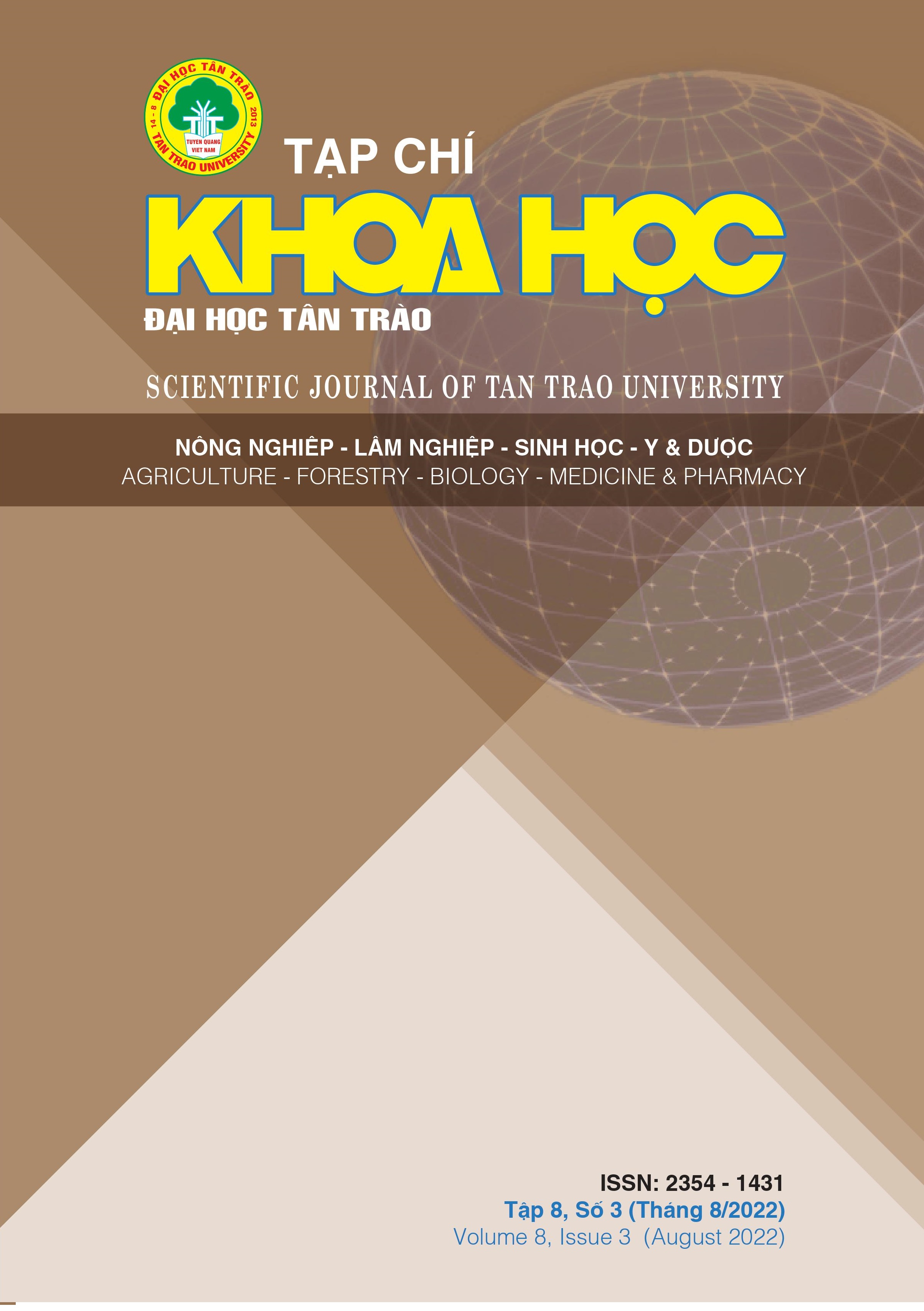THÀNH PHẦN HÓA HỌC VÀ HOẠT TÍNH CHỐNG OXI HÓA CỦA CAO ETHYL ACETATE CÂY BA KÍCH (MORINDA OFFICINALIS ) Ở TỈNH ĐẮK LẮK
Từ khóa:
Ba kiÌch, GS-MS, ethyl acetate, hoạt tÃnh kháng oxi hóa, Äắk LắkTóm tắt
Cây Ba kích (Morinda officinalis) là một loài cây thảo dược quý thuộc chi Nhàu (Morinda L.), họ cà phê (Rubiacea), trong tự nhiên thường phân bố ở các tỉnh miền núi phía Bắc, khu vực Tây Nguyên Việt Nam và tỉnh Quảng Tây của Trung Quốc. Hiện nay, cây Ba kích đang được nhân giống trồng đại trà ở tỉnh Đắk Lắk và được sử dụng rộng rãi như một loại dược liệu. Trong nghiên cứu này, chúng tôi tiến hành xác định thành phần hóa học của cao chiết được xác định bằng phương pháp sắc ký khí ghép khối phổ GC-MS và đánh giá hoạt tính kháng oxi hóa của cao chiết ethyl acetate rễ loài cây này bằng phương pháp DPPH. Kết quả xác định được 15 hợp chất từ cao chiết ethyl acetate của rễ cây Ba kích (Morinda officinalis), trong đó có các lớp chất chính là: anthraquinon, triterpen, các acid hữu cơ. Kết quả đánh giá hoạt tính khoáng oxi hóa cao chiết ethyl acetate cho thấy cao chiết ethyl acetate có khả năng kháng oxi hóa rất tốt với giá trị IC50 = 3,33 mg/ml, mạnh hơn 10,5 lần so với chất đối chứng dương acid ascorbic (IC50 = 34,99 mg/ml).
Tải xuống
Tài liệu tham khảo
[1]. Ministry of Health. (2009). Vietnamese Pharmacopoeia IV. Medical Publishing House, Vietnam.
[2]. Zhenhua Luo, Zien Chen, Mengyun Liu, Li Yang, Zhimin Zhao, Depo Yang and Ping Ding. (2022). Phenotypic, chemical component and molecular assessment of genetic diversity and population structure of Morinda ofcinalis germplasm. Luo et al. BMC Genomics 23:605, P.1-17.
[3]. Chieu, N. (2001). Primary results of the investigation of planting Ba kich in Phu Tho, Journal of Pharmacology, 297(1):6-9.
[4]. Loi, V. D., Vung, N. T., An, N. T. T. (2016). Some compounds isolated from the roots of Morinda officinalis How grown in Quang Ninh province. Journal of Pharmacology, 485(9):36-41.
[5]. Quan, N. M., Huong, N. T. G. (2008). Study on the effect of Morinda officinalis How on the development of male rat genitals, Medical Research Journal, 53(1):77-84.
[6]. Tien, T. M., Tam, N. M. T., Luan, T. C., Huong, N. Thi. T. (2012). Study on the androgenic effect of Morinda officinalis How. Medical Journal of Ho Chi Minh City, 16 (1):192-198.
[7]. Wu,Y. B., Wu, J. G., Zheng, C. J., Han, T., Qin, L. P., Wu, J. Z., Zhang, Q. Y. (2013). Quantitative and chemical profiles analysis of the root of Morinda officinalis based on reversed-phase high performance liquid chromatography combined with chemometrics methods. Journal of Medicinal Plants Research, 7(30):2249 - 2258.
[8]. Yoon, K. L., Hyo, J. B., Jeong, B. O., Wan, K. W. (2017). Bioassay-Guided Isolated Compounds from Morinda offificinalis Inhibit Alzheimer’s Disease Pathologies. Molecule, 22:1638.
[9]. Hung, T. V., Kien, P. V., Thai, B. Q., Son, D. C., Dat, N. T., Cuong, B. H. (2017). Study on extracting, isolating and purifying monotropein from the root of Morinda offificinalis to establish standard substances. Journal of Pharmacology, 57 (5):40 – 42.
[10]. Zang, J. H., Xin, H. L., Xu, Y. M., Shen, Y., He, . Y. Q., Hsien-Yeh, Lin, B., Song, H. T., Juan-Liu, Yang, H. Y., Qin, L. P., Zhang, Q. Y., Du, J. (2018). Morinda officinalis How. - A comprehensive review of traditional uses, phytochemistry and pharmacology. Journal of Ethnopharmacology, 213:230-255.
[11]. Yoshikawa, M., Yamaguchi, S., Nishisaka, H., Yamahara, J., Murakami, N. (1995). Chemical constituents of Chinese nature medicine, morindae radix, the dried roots of Morinda officinalis How: Structures of morindolide and morofficinaloside. Chemical and Pharmaceutical Bulletin, 43(9):1462-1465.
Tải xuống
Đã Xuất bản
Cách trích dẫn
Số
Chuyên mục
Giấy phép

Tác phẩm này được cấp phép theo Giấy phép Quốc tế Creative Commons Attribution-ShareAlike 4.0 .
Bài báo được xuất bản ở Tạp chí Khoa học Đại học Tân Trào được cấp phép theo giấy phép Ghi công - Chia sẻ tương tự 4.0 Quốc tế (CC BY-SA). Theo đó, các tác giả khác có thể sao chép, chuyển đổi hay phân phối lại các bài báo này với mục đích hợp pháp trên mọi phương tiện, với điều kiện họ trích dẫn tác giả, Tạp chí Khoa học Đại học Tân Trào và đường link đến bản quyền; nêu rõ các thay đổi đã thực hiện và các nghiên cứu đăng lại được tiến hành theo cùng một bản quyền.
Bản quyền bài báo thuộc về các tác giả, không hạn chế số lượng. Tạp chí Khoa học Tân Trào được cấp giấy phép không độc quyền để xuất bản bài báo với tư cách nhà xuất bản nguồn, kèm theo quyền thương mại để in các bài báo cung cấp cho các thư viện và cá nhân.
Mặc dù các điều khoản của giấy phép CC BY-SA không dành cho các tác giả (với tư cách là người giữ bản quyền của bài báo, họ không bị hạn chế về quyền hạn), khi gửi bài tới Tạp chí Khoa học Đại học Tân Trào, tác giả cần đáp ứng quyền của độc giả, và cần cấp quyền cho bên thứ 3 sử dụng bài báo của họ trong phạm vi của giấy phép.






